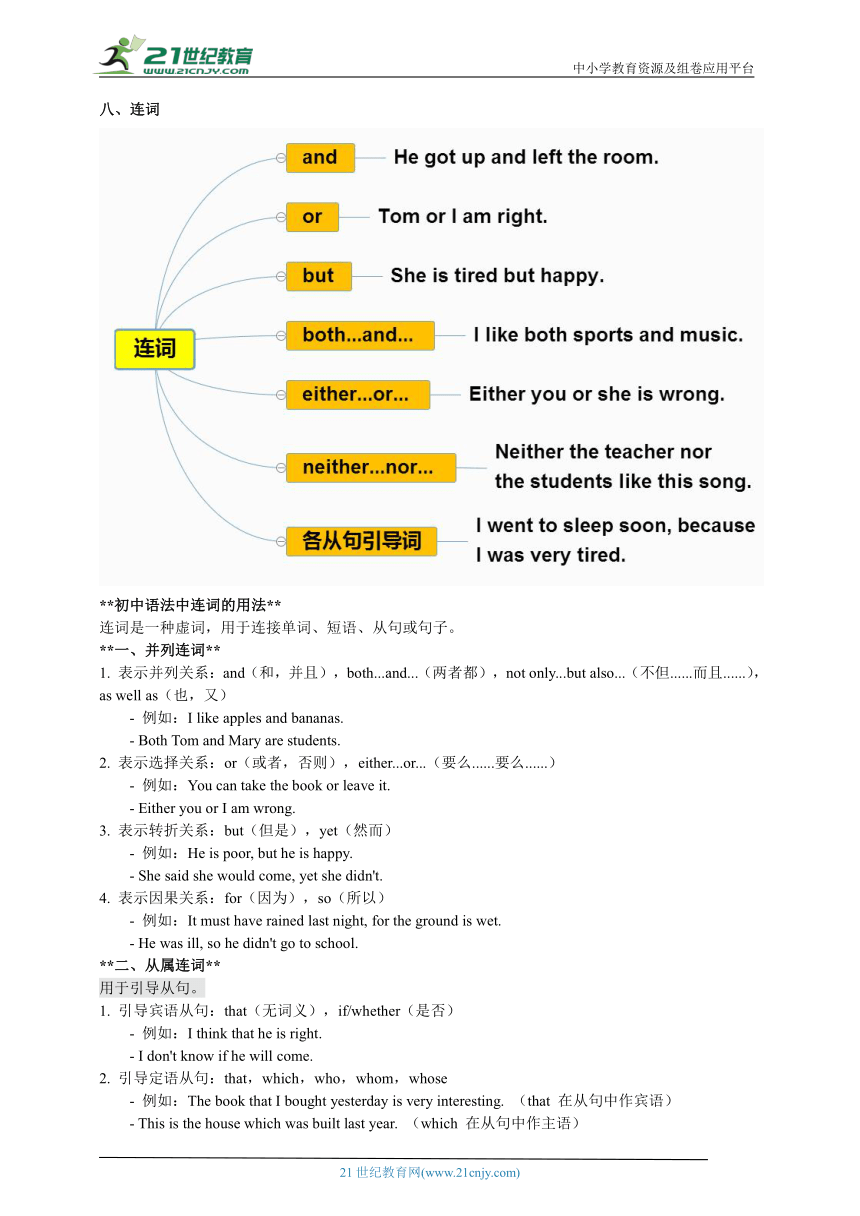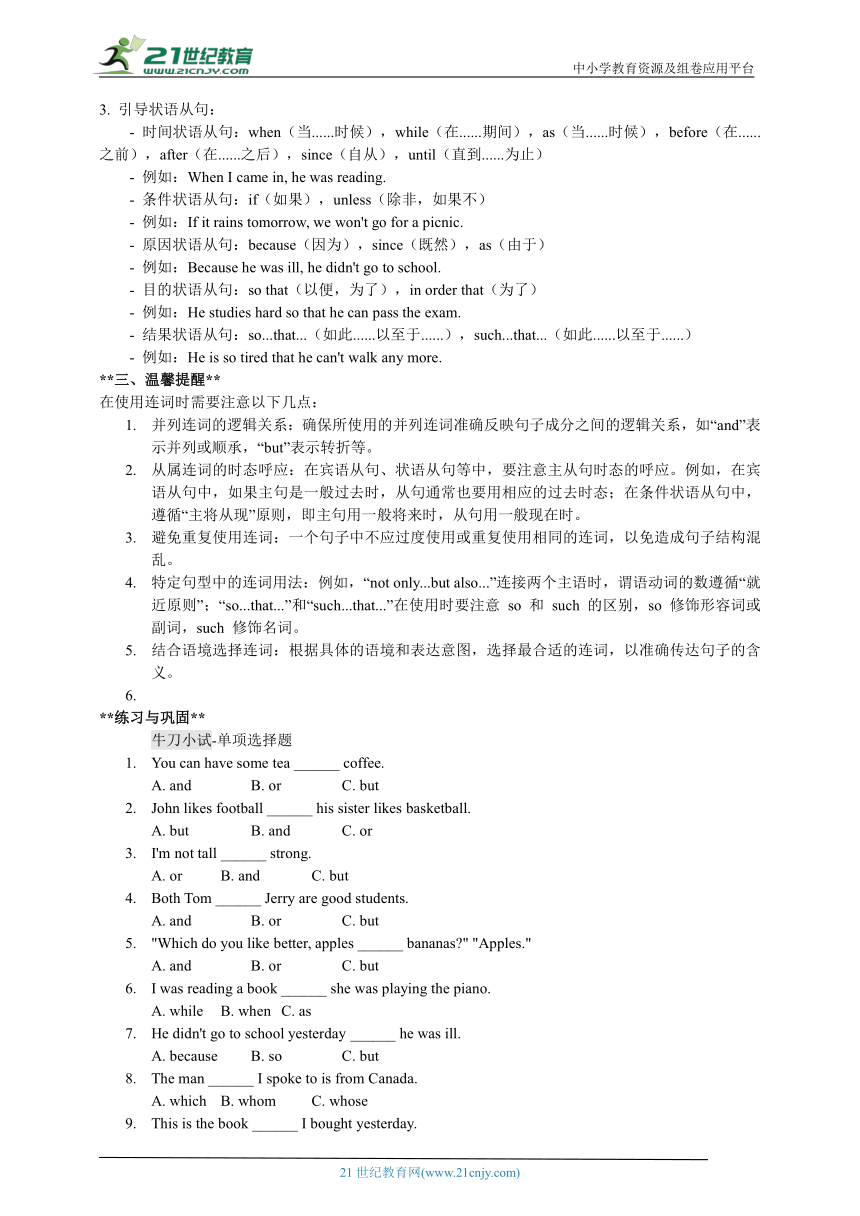八、连词-精讲精练【思维导图突破初中英语语法】(含答案)
文档属性
| 名称 | 八、连词-精讲精练【思维导图突破初中英语语法】(含答案) |  | |
| 格式 | doc | ||
| 文件大小 | 223.8KB | ||
| 资源类型 | 试卷 | ||
| 版本资源 | 通用版 | ||
| 科目 | 英语 | ||
| 更新时间 | 2024-07-23 10:01:17 | ||
图片预览


文档简介
中小学教育资源及组卷应用平台
八、连词
**初中语法中连词的用法**
连词是一种虚词,用于连接单词、短语、从句或句子。
**一、并列连词**
1. 表示并列关系:and(和,并且),both...and...(两者都),not only...but also...(不但......而且......),as well as(也,又)
- 例如:I like apples and bananas.
- Both Tom and Mary are students.
2. 表示选择关系:or(或者,否则),either...or...(要么......要么......)
- 例如:You can take the book or leave it.
- Either you or I am wrong.
3. 表示转折关系:but(但是),yet(然而)
- 例如:He is poor, but he is happy.
- She said she would come, yet she didn't.
4. 表示因果关系:for(因为),so(所以)
- 例如:It must have rained last night, for the ground is wet.
- He was ill, so he didn't go to school.
**二、从属连词**
用于引导从句。
1. 引导宾语从句:that(无词义),if/whether(是否)
- 例如:I think that he is right.
- I don't know if he will come.
2. 引导定语从句:that,which,who,whom,whose
- 例如:The book that I bought yesterday is very interesting. (that 在从句中作宾语)
- This is the house which was built last year. (which 在从句中作主语)
3. 引导状语从句:
- 时间状语从句:when(当......时候),while(在......期间),as(当......时候),before(在......之前),after(在......之后),since(自从),until(直到......为止)
- 例如:When I came in, he was reading.
- 条件状语从句:if(如果),unless(除非,如果不)
- 例如:If it rains tomorrow, we won't go for a picnic.
- 原因状语从句:because(因为),since(既然),as(由于)
- 例如:Because he was ill, he didn't go to school.
- 目的状语从句:so that(以便,为了),in order that(为了)
- 例如:He studies hard so that he can pass the exam.
- 结果状语从句:so...that...(如此......以至于......),such...that...(如此......以至于......)
- 例如:He is so tired that he can't walk any more.
**三、温馨提醒**
在使用连词时需要注意以下几点:
并列连词的逻辑关系:确保所使用的并列连词准确反映句子成分之间的逻辑关系,如“and”表示并列或顺承,“but”表示转折等。
从属连词的时态呼应:在宾语从句、状语从句等中,要注意主从句时态的呼应。例如,在宾语从句中,如果主句是一般过去时,从句通常也要用相应的过去时态;在条件状语从句中,遵循“主将从现”原则,即主句用一般将来时,从句用一般现在时。
避免重复使用连词:一个句子中不应过度使用或重复使用相同的连词,以免造成句子结构混乱。
特定句型中的连词用法:例如,“not only...but also...”连接两个主语时,谓语动词的数遵循“就近原则”;“so...that...”和“such...that...”在使用时要注意 so 和 such 的区别,so 修饰形容词或副词,such 修饰名词。
结合语境选择连词:根据具体的语境和表达意图,选择最合适的连词,以准确传达句子的含义。
**练习与巩固**
牛刀小试-单项选择题
You can have some tea ______ coffee.
A. and B. or C. but
John likes football ______ his sister likes basketball.
A. but B. and C. or
I'm not tall ______ strong.
A. or B. and C. but
Both Tom ______ Jerry are good students.
A. and B. or C. but
"Which do you like better, apples ______ bananas " "Apples."
A. and B. or C. but
I was reading a book ______ she was playing the piano.
A. while B. when C. as
He didn't go to school yesterday ______ he was ill.
A. because B. so C. but
The man ______ I spoke to is from Canada.
A. which B. whom C. whose
This is the book ______ I bought yesterday.
A. which B. who C. whose
She is such a lovely girl ______ everyone likes her.
A. that B. which C. as
答案:
B (选择关系,用“or”,“或者”)
A (前后句子意思转折,用“but”,“但是”)
A (否定句中连接两个并列成分用“or”)
A (“Both...and...”,“......和......都”)
B (选择疑问句用“or”)
A (“while”强调两个动作同时进行)
A (“didn't go to school”和“was ill”是因果关系,“because”表原因)
B (先行词“the man”在从句中作宾语,且指人,用“whom”)
A (先行词“the book”在从句中作宾语,用“which”)
A (“such...that...”表示“如此......以至于......”)
巩固加强-结合语句意思,在空格处填入一个合适的单词
I like apples ______ bananas.
He is poor, ______ he is happy.
You can come on Monday ______ Tuesday.
______ you study hard, you will pass the exam.
I was doing my homework ______ my father was reading a newspaper.
He didn't go to school ______ he was ill.
The girl ______ I met yesterday is very nice.
This is the book ______ I bought last week.
I'll call you ______ I arrive in Beijing.
She is such a lovely girl ______ everyone likes her.
答案
and
but
or
If
while
because
whom / that
that / which
when
that
解析
“apples”和“bananas”是并列关系,用“and”连接。
“poor”和“happy”是转折关系,用“but”连接。
“Monday”和“Tuesday”是选择关系,用“or”连接。
此句是条件状语从句,“If”表示“如果”。
“was doing my homework”和“was reading a newspaper”两个动作同时进行,用“while”。
“didn't go to school”是结果,“he was ill”是原因,用“because”引导原因状语从句。
先行词“the girl”在从句中作宾语,可用“whom”或“that”。
先行词“the book”在从句中作宾语,可用“that”或“which”。
“I arrive in Beijing”是一个时间点,用“when”表示“当......时候”。
“such...that...”表示“如此......以至于......”,引导结果状语从句。
21世纪教育网 www.21cnjy.com 精品试卷·第 2 页 (共 2 页)
HYPERLINK "http://21世纪教育网(www.21cnjy.com)
" 21世纪教育网(www.21cnjy.com)
八、连词
**初中语法中连词的用法**
连词是一种虚词,用于连接单词、短语、从句或句子。
**一、并列连词**
1. 表示并列关系:and(和,并且),both...and...(两者都),not only...but also...(不但......而且......),as well as(也,又)
- 例如:I like apples and bananas.
- Both Tom and Mary are students.
2. 表示选择关系:or(或者,否则),either...or...(要么......要么......)
- 例如:You can take the book or leave it.
- Either you or I am wrong.
3. 表示转折关系:but(但是),yet(然而)
- 例如:He is poor, but he is happy.
- She said she would come, yet she didn't.
4. 表示因果关系:for(因为),so(所以)
- 例如:It must have rained last night, for the ground is wet.
- He was ill, so he didn't go to school.
**二、从属连词**
用于引导从句。
1. 引导宾语从句:that(无词义),if/whether(是否)
- 例如:I think that he is right.
- I don't know if he will come.
2. 引导定语从句:that,which,who,whom,whose
- 例如:The book that I bought yesterday is very interesting. (that 在从句中作宾语)
- This is the house which was built last year. (which 在从句中作主语)
3. 引导状语从句:
- 时间状语从句:when(当......时候),while(在......期间),as(当......时候),before(在......之前),after(在......之后),since(自从),until(直到......为止)
- 例如:When I came in, he was reading.
- 条件状语从句:if(如果),unless(除非,如果不)
- 例如:If it rains tomorrow, we won't go for a picnic.
- 原因状语从句:because(因为),since(既然),as(由于)
- 例如:Because he was ill, he didn't go to school.
- 目的状语从句:so that(以便,为了),in order that(为了)
- 例如:He studies hard so that he can pass the exam.
- 结果状语从句:so...that...(如此......以至于......),such...that...(如此......以至于......)
- 例如:He is so tired that he can't walk any more.
**三、温馨提醒**
在使用连词时需要注意以下几点:
并列连词的逻辑关系:确保所使用的并列连词准确反映句子成分之间的逻辑关系,如“and”表示并列或顺承,“but”表示转折等。
从属连词的时态呼应:在宾语从句、状语从句等中,要注意主从句时态的呼应。例如,在宾语从句中,如果主句是一般过去时,从句通常也要用相应的过去时态;在条件状语从句中,遵循“主将从现”原则,即主句用一般将来时,从句用一般现在时。
避免重复使用连词:一个句子中不应过度使用或重复使用相同的连词,以免造成句子结构混乱。
特定句型中的连词用法:例如,“not only...but also...”连接两个主语时,谓语动词的数遵循“就近原则”;“so...that...”和“such...that...”在使用时要注意 so 和 such 的区别,so 修饰形容词或副词,such 修饰名词。
结合语境选择连词:根据具体的语境和表达意图,选择最合适的连词,以准确传达句子的含义。
**练习与巩固**
牛刀小试-单项选择题
You can have some tea ______ coffee.
A. and B. or C. but
John likes football ______ his sister likes basketball.
A. but B. and C. or
I'm not tall ______ strong.
A. or B. and C. but
Both Tom ______ Jerry are good students.
A. and B. or C. but
"Which do you like better, apples ______ bananas " "Apples."
A. and B. or C. but
I was reading a book ______ she was playing the piano.
A. while B. when C. as
He didn't go to school yesterday ______ he was ill.
A. because B. so C. but
The man ______ I spoke to is from Canada.
A. which B. whom C. whose
This is the book ______ I bought yesterday.
A. which B. who C. whose
She is such a lovely girl ______ everyone likes her.
A. that B. which C. as
答案:
B (选择关系,用“or”,“或者”)
A (前后句子意思转折,用“but”,“但是”)
A (否定句中连接两个并列成分用“or”)
A (“Both...and...”,“......和......都”)
B (选择疑问句用“or”)
A (“while”强调两个动作同时进行)
A (“didn't go to school”和“was ill”是因果关系,“because”表原因)
B (先行词“the man”在从句中作宾语,且指人,用“whom”)
A (先行词“the book”在从句中作宾语,用“which”)
A (“such...that...”表示“如此......以至于......”)
巩固加强-结合语句意思,在空格处填入一个合适的单词
I like apples ______ bananas.
He is poor, ______ he is happy.
You can come on Monday ______ Tuesday.
______ you study hard, you will pass the exam.
I was doing my homework ______ my father was reading a newspaper.
He didn't go to school ______ he was ill.
The girl ______ I met yesterday is very nice.
This is the book ______ I bought last week.
I'll call you ______ I arrive in Beijing.
She is such a lovely girl ______ everyone likes her.
答案
and
but
or
If
while
because
whom / that
that / which
when
that
解析
“apples”和“bananas”是并列关系,用“and”连接。
“poor”和“happy”是转折关系,用“but”连接。
“Monday”和“Tuesday”是选择关系,用“or”连接。
此句是条件状语从句,“If”表示“如果”。
“was doing my homework”和“was reading a newspaper”两个动作同时进行,用“while”。
“didn't go to school”是结果,“he was ill”是原因,用“because”引导原因状语从句。
先行词“the girl”在从句中作宾语,可用“whom”或“that”。
先行词“the book”在从句中作宾语,可用“that”或“which”。
“I arrive in Beijing”是一个时间点,用“when”表示“当......时候”。
“such...that...”表示“如此......以至于......”,引导结果状语从句。
21世纪教育网 www.21cnjy.com 精品试卷·第 2 页 (共 2 页)
HYPERLINK "http://21世纪教育网(www.21cnjy.com)
" 21世纪教育网(www.21cnjy.com)
同课章节目录
- 词法
- 名词
- 动词和动词短语
- 动词语态
- 动词时态
- 助动词和情态动词
- 非谓语动词
- 冠词
- 代词
- 数词和量词
- 形容词副词及其比较等级
- 介词和介词短语
- 连词和感叹词
- 构词法
- 相似、相近词比较
- 句法
- 陈述句
- 一般疑问句和否定疑问句
- 特殊疑问句及选择疑问句
- 反意疑问句
- 存在句(There be句型)
- 宾语从句
- 定语从句
- 状语从句
- 主谓一致问题
- 简单句
- 并列句
- 复合句
- 主谓一致
- 主、表语从句
- 名词性从句
- 直接引语和间接引语
- 虚拟语气
- 感叹句
- 强调句
- 倒装句
- 祈使句
- 句子的成分
- 句子的分类
- 题型专区
- 单项选择部分
- 易错题
- 完形填空
- 阅读理解
- 词汇练习
- 听说训练
- 句型转换
- 补全对话
- 短文改错
- 翻译
- 书面表达
- 任务型阅读
- 语法填空
- 其他资料
